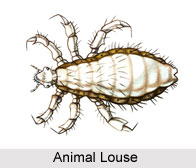
The Indian animal louse is a parasitic insect belonging to the order Phthiraptera, which includes small wingless insects. These parasites are primarily divided into two main groups: Amblycera and Ischnocera, known as chewing or biting lice, and Anoplura, known as sucking lice. Chewing lice infest both birds and mammals, whereas sucking lice are exclusive to mammals. This article explores the physical characteristics, habitat, and distribution of lice in India, focusing on their impact on both human and animal hosts.
Physical Features
Animal Lice are characterized by their flattened bodies, which range in size from 0.33 mm to 11 mm. They exhibit a variety of colors, including whitish, yellow, brown, and black. Their physical structure is well-adapted for their parasitic lifestyle. Chewing lice possess mouthparts designed to gnaw on feathers, skin debris, and occasionally tissue fluids. In contrast, sucking lice have specialized mouthparts with delicate stylets for piercing the skin and sucking blood. These stylets are retracted into the head when not in use, and their feeding is facilitated by a salivary secretion that prevents blood coagulation.
Habitat
Lice are highly adapted to their hosts, thriving in the warmth and darkness provided by feathers or fur. They are repelled by light and are thus rarely found away from their hosts. Chewing lice are prevalent on birds, where they feed on feathers and skin debris, while sucking lice infest mammals, feeding exclusively on blood. The population density of lice can vary significantly depending on the health of the host. Sick animals or birds with impaired grooming capabilities may harbor abnormally large numbers of lice.
Distribution in India
In India, lice infest a wide range of birds and mammals, including domestic animals such as dogs, cattle, and poultry. The tropical and subtropical climate of India provides an ideal environment for these parasites to thrive. Sucking lice, such as those infesting cattle, can have significant economic impacts by reducing meat and milk production. Chewing lice on poultry can lead to damaged feathers and decreased egg production.
Impact on Humans
The human louse, a type of sucking louse, is a significant concern in areas with poor hygiene and overcrowding. It is a vector for serious diseases such as typhus and louse-borne relapsing fever. The prevalence of head lice in India is notable, particularly in densely populated regions where conditions for lice transmission are optimal. Despite the use of insecticidal shampoos, resistance has developed, leading to a resurgence of infestations.
Impact on Animals
Lice infestations in domestic animals can lead to severe discomfort, skin irritation, and secondary infections due to scratching. For instance, the dog louse can serve as an intermediate host for the dog tapeworm, further complicating health issues. In cattle, heavy infestations can result in significant economic losses. In poultry, lice not only damage feathers but also lead to reduced egg and meat production, affecting the livelihood of farmers.
The Indian animal louse, encompassing both chewing and
sucking varieties, presents a significant parasitic challenge to both humans
and animals. Their physical adaptations make them well-suited to their
parasitic lifestyle, thriving in the warmth and protection provided by their
hosts. In India, the climate and conditions facilitate their prevalence, with
notable impacts on health and economic productivity. Effective management and
control strategies are essential to mitigate the adverse effects of lice infestations
in this region.